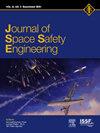Iterating on a design – further developments in the evolution of the ballistic limit equations for the Mars Sample Return Project
IF 1.7
Q3 ENGINEERING, AEROSPACE
引用次数: 0
Abstract
The goal of the Mars Sample Return–Capture, Containment, and Return System Project is to retrieve samples launched from the Martian surface and return them to Earth for detailed analysis. An important part of this project is the design of the system's micrometeoroid protection system, which protects the Earth Entry System and the collected samples during their journey back to Earth. As mission parameters and the micrometeoroid and orbital debris threat became better understood, the design of the micrometeoroid protection system evolved. A key element used in the shield development process is the ballistic limit equation, which is an equation that is used to determine whether or not a particular structural element or system will end up in a failed state as a result of a specified impact. As the design of the Earth Entry System and the micrometeoroid protection system evolved, a new set of ballistic limit equations was needed to better predict and assess the performance of developing shield system designs in anticipation of possible damage from micrometeoroid and orbital debris particle impacts. This paper provides a summary of how a set of initial BLEs were either extended or modified so that the resulting equations were better suited to new types of target configurations being considered, as well as how additional ballistic limit equations were developed where none previously existed.
设计的迭代——火星样本返回计划弹道极限方程演化的进一步发展
火星样本回收、捕获、遏制和返回系统项目的目标是从火星表面回收发射的样本,并将其返回地球进行详细分析。该项目的一个重要组成部分是系统的微流星体保护系统的设计,该系统在地球进入系统和收集的样本返回地球的过程中保护它们。随着任务参数以及对微流星体和轨道碎片威胁的进一步了解,微流星体防护系统的设计也在不断发展。在盾构开发过程中使用的一个关键要素是弹道极限方程,该方程用于确定特定结构元件或系统是否会由于特定的冲击而最终处于失效状态。随着地球入口系统和微流星体防护系统设计的不断发展,需要一套新的弹道极限方程来更好地预测和评估正在开发的防护系统设计的性能,以预测微流星体和轨道碎片粒子撞击可能造成的损害。本文概述了如何对一组初始极限方程进行扩展或修改,以使所得到的方程更适合所考虑的新型目标构型,以及如何在以前没有弹道极限方程的情况下开发额外的弹道极限方程。
本文章由计算机程序翻译,如有差异,请以英文原文为准。
求助全文
约1分钟内获得全文
求助全文
来源期刊

Journal of Space Safety Engineering
Engineering-Safety, Risk, Reliability and Quality
CiteScore
2.50
自引率
0.00%
发文量
80
 求助内容:
求助内容: 应助结果提醒方式:
应助结果提醒方式:


